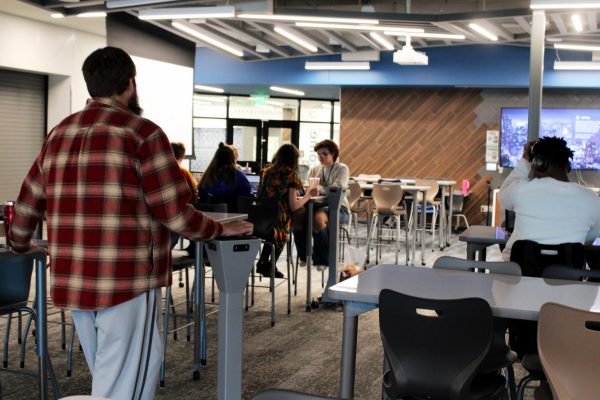The Achievement Gap
Definition of ACHIEVEMENT GAP
noun achieve ment ə-ˈchēv-mənt gap_
Any significant and persistent disparity in academic performance or educational attainment between different groups of students.
The Glossary of Education Reform
The Gender Gap
There was a time when people thought girls were not cut out for science, technology, engineering and mathematic classes (STEM). However, as more national attention was drawn to the issue, it became apparent that female students are able to achieve at the same level as their male counterparts in high level STEM classes. However, female students are still not enrolling in STEM classes at the same numbers.
The AP Physics II class at LHS has 30 students, but only four students are female. The AP Calculus BC class has seven female students of 22 students. According to AP Physics II and AP Calculus BC enrollment and ACT scores, the lack of equal representation in these classes has nothing to do with female students’ ability to achieve at the same level as males.
In 2016, average science ACT scores for LHS female students were only one tenth of a point lower than male students. For the math section, female students were only half a point lower. So why are there so few female students taking these classes?
“From my experience, when there are more girls in the room there seems to be an air of confidence for the girls,” teacher Angie Klein said. “When there are less girls there is less confidence in the individual girl.”
Even though female students are just as capable as males to do well in upper-level STEM classes, they choose not to take these classes, possibly due to a lack of other female students.
“If I weren’t confident in those classes I would probably be super uncomfortable because I don’t have any friends in the class,” sophomore Addie Morgan said. “It’s kind of hard to take a class like that when you know you are going to be in that situation.”
However, not all upper-level STEM classes are male dominated. In AP Biology, the class is made up of 77% females. The same goes for College Chemistry with 52% females and College Algebra with 65% females. The reason why some classes are equally populated with female students and why others don’t show equal representation may have a basis in career goals.
“I believe a possible reason is that some classes are more closely related to the healthcare field,” counselor Brenda Wiederholt said. “Thus, females would be more inclined to take that course because historically the healthcare field is equally populated with males and females. Whereas, some STEM careers, such as engineering, are heavily male dominated.”
This theory is not far-fetched. According to the National Girls Collaborative Project, only 15% of people in the engineering workforce are women. This issue isn’t just present in the professional world. LHS’s Principles of Engineering class has only three female students out of 33 students. Intro to Engineering and Design has 14 females of 59 students. The other two engineering classes are both only 30% female students. Students walking into computer classes will also see a striking difference between the number of females and males.
“This is our sixth year of teaching AP [Computer Science] and the first couple years there were no girls,” Klein said. “This year, between the two classes, we’ve had five girls. Five girls out of less than 20 is pretty outstanding compared to six years ago.”
Klein does not see this as an achievement problem for female students. She sees it as female students simply choosing other paths.
“It hasn’t really discouraged me. I’ve always been told, ‘Hey you’re smart. You can do this if you want to do it. Go do it,’” senior Emily Seever said.
The Race Gap
Another gap exists for minority students. Although 81% of LHS students are Caucasian, the AP scores reflect a variety of gaps. Students may enroll in AP classes but it’s their choice to take the course exam.
For example, 265 AP tests were given in 2016 to students at LHS. Proportionally, 18 tests should have been given to African-American students but only seven were taken. It is important to consider that with a proportional amount of tests given, if one person scores lower, the entire average drops down significantly. The average AP score for African-American students was a 3.0, for Asian students a 3.73, Hispanic students 2.8 and Caucasian students 3.2.
Although there is the appearance of disproportional representation of minority students in AP or Advanced classes, the overall demographic within LHS needs to be acknowledged. Out of 1,697 students enrolled in LHS, 116 (7%) are African-American, 53 (3%) are Asian, 102 (6%) are Hispanic, 10 (.05%) are Indian, six (.03%) are Pacific Islander, 31 (2%) are mixed and 1,378 (81%) are Caucasian.
Regardless of where racial proportions rest, the school does their best to provide equal opportunities for every student.
“There’s a couple of things you really want in your high school and that’s legitimacy,” assistant principal Brett Coffman said. “Legitimacy is that your classes are fair and equal, there is an ability for everyone to come in and learn. There’s a diversity of thought in those classes so when you lack that diversity of thought you actually don’t get the full effect of instruction.”
Solutions
To educators, it’s possible to close the gaps. The first step is raising awareness.
Female students need to be aware of STEM classes from the beginning of their education. Through organizations like Girls Who Code, which has summer programs to teach computing and programing skills to girls, middle school can be the beginning.Story by Photo by Ashley Ritter
Wiederholt reminds everyone that LHS provides help to those who want it. One of the programs offered is the After School Educational Mentoring Program, or ASEM for short, which is sponsored by the Clay County African American Legacy, Inc. The program has volunteers from William Jewell College who mentor students every Tuesday during Liberty Hour in the StuCo room.
Also, there are clubs right here at LHS that are already hard at work recognizing and trying to solve these issues. Women’s Issues Now is a club where students discuss women’s issues while trying to educate and raise awareness to students. Another club, Diversity Council, helps increase awareness and acceptance for people’s differences. A third club is League of United Latin American Citizens (LULAC), which helps try to advance educational attainment of the Hispanic population in the U.S.
Before it was a state requirement, LHS gave the ACT to every junior, giving every student free access to this college entrance exam. Starting this school year, sophomores will take the pre-ACT and next year freshmen will be added to the list. This will help administrators see if there are holes in academic progress and continue to help all students have the same opportunities in school.
Another solution is to attend the daily tutoring time built into student class schedules: Liberty Hour. During this time students can get help from teachers for classes in which they are struggling.
In the first semester 12,226 Liberty Hour sessions were assigned and 9,361 of those were attended. While it’s not a 100% attendance rate, it’s a high number that shows the growing importance of having Liberty Hour. Of the 1,153 students assigned to a Liberty Hour session, only 588 have never missed one. That number needs to grow, but that takes student commitment. This time gives students an opportunity to close the gap between themselves and their peers.
Next year the school will support students to be the first in their family to go to college through a program of guest lectures, lessons, discussions and encouraging upper level classes in all areas for college career success.
“Our country has a history of offering inconsistent educational opportunities for students due to race, ethnicity or gender,” Wiederholt said. “All students need to be offered the same opportunities and encouraged to succeed.”





